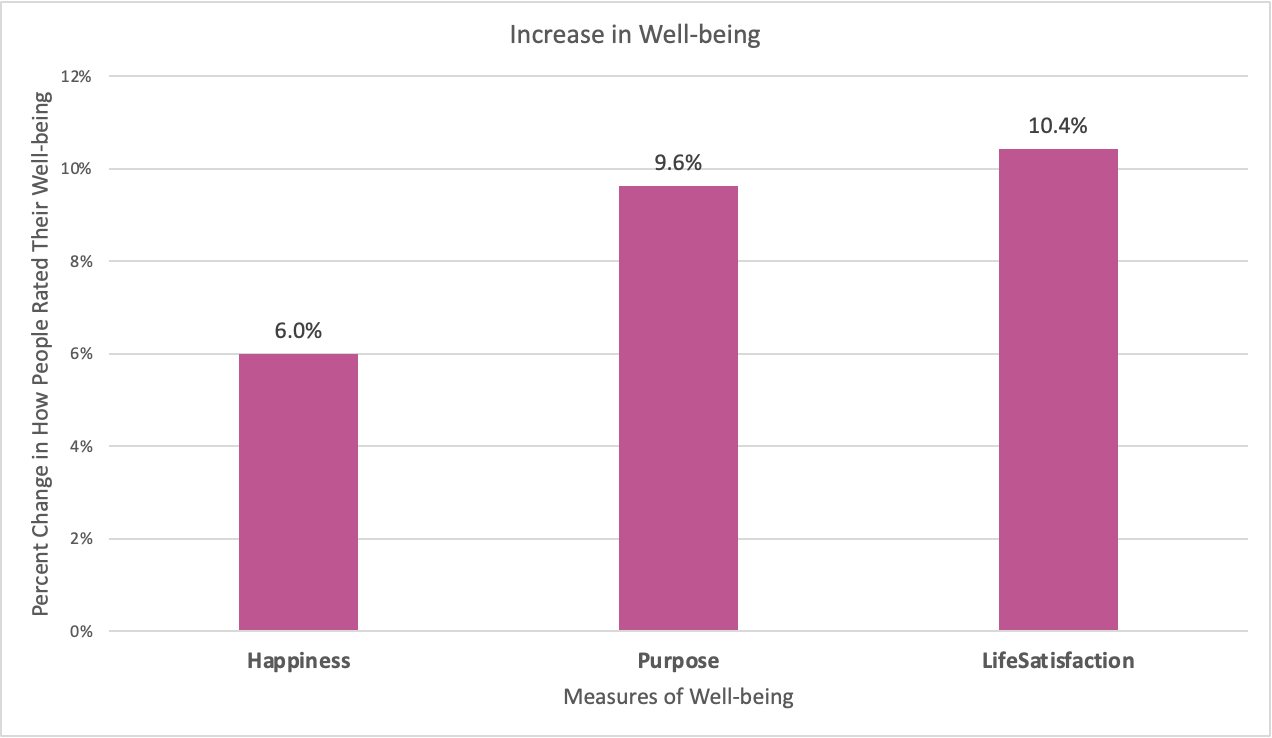Have you ever felt motivated to improve your own happiness—but had trouble finding practices for doing so? To help people find what can work for them, we at the Greater Good Science Center created a four-week interactive program on our Greater Good in Action (GGIA) website called the Pathway to Happiness (P2H)—and we invited the Greater Good community to try it out.

Upon enrolling, P2H invites people to fill out a survey, and one of the questions is: “What do you want to work on?” I chose “managing stress,” and the first practice GGIA suggested was “Finding Silver Linings,” which asked me to think of an upsetting situation and then try to find some of its upsides.
I did this practice for 10 minutes a day while brushing my teeth and winding down before bed, and it really helped me fall asleep. The next morning, I woke up feeling better rested. Finding Silver Linings has become a healthy habit in my daily life, as have a few of the other practices that I discovered during my P2H, like “Three Good Things,” which only takes a minute, but makes me feel a lot better.
I’m not alone. We analyzed data from just under 5,000 people who tried P2H between November 2022 and March 2023. Our preliminary analysis is helping us begin to understand who is drawn to this kind of experience:
- More than four times as many women as men enrolled in P2H, did the surveys, and completed their pathway.
- We also observed a much higher proportion of people over 40 years old among those who completed their P2H.
- The vast majority of participants rated themselves as middle-class to upper-middle-class.
- Among people who completed their pathway, 61% identified their own race as white and 19% as Asian or Asian American. People who described themselves as Black constituted 3%; Latinos stood at 5%. Only 1% were Middle Eastern or Native American.
We also analyzed the P2H data to investigate how it affected this group according to their responses to questions on a survey that they filled out before starting and after completing the four-week program. Here’s what we found.
They were happier after completing P2H
At the GGSC, we define happiness not as a momentary state of enjoyment or pleasure in response to a specific experience, but as a more general characteristic of life that encompasses being ready and able to feel joyful emotions in appropriate situations, feeling like you matter to others and in the world, and thinking that your life is good.
At the beginning and end of P2H, participants report their level of agreement with three statements meant to capture their level of overall subjective well-being in life:
- Over the past week, I have felt satisfied with my life.
- Over the past week, I have felt a sense of meaning and purpose in my life.
- Over the past week, I have felt happy.
In fact, on average among the people who answered all of the survey questions before and after P2H, scores for life satisfaction jumped by 10%; meaning and purpose in life rose by nearly 10%, and feelings of happiness increased by 6%.

Most felt they became more virtuous
Another series of questions on the P2H surveys asked people to rate their own levels of a list of different character virtues.
Compared to before starting P2H, people rated themselves higher on each virtue measured after P2H, though to varying degrees. The biggest changes were for self-compassion, social connection, gratitude, and resilience to stress. There were smaller changes for compassion, kindness, forgiveness, awe, and optimism. This difference in impact may be related to higher pre-P2H scores, which mean less room for improvement.

It is encouraging to see that P2H can increase people’s perceptions of their overall happiness in just four weeks. We hope that the skills from practices that people learn in P2H can have a sustained impact, lasting months or even years.
In fact, a 2022 study published in Nature Human Behavior found that appreciating small moments, a practice not too different from the “Finding Silver Linings” and “Three Good Things” practices in P2H, effectively enhances meaning in life. It’s important to note that although we visualize each virtue score separately, there is overlap between these virtues; they can have interdependent and synergistic effects.
For example, increasing empathy is very likely to also increase compassion. As evidence to this effect, many studies report how practicing gratitude strengthens relationships, promotes forgiveness, and makes us more resilient, helpful, and altruistic. In a similar vein, studies find that mindfulness makes us more likely to help someone in need and helps us become more compassionate toward others and ourselves.
We hope our update from our preliminary analysis of responses from people who engaged with P2H can be encouraging. However, there are limitations to our analysis, and it should not be considered a rigorous scientific finding.
For example, our sample is self-selected, which means it includes people who are interested in this topic and who possibly already believe it will benefit them. Our findings do not include data from a control group—people who would do something like P2H but without the happiness-strengthening part—to show that just doing something for four weeks and answering surveys is not the reason people’s responses to survey questions changed. These findings are more like an evaluation of P2H that can help us understand what kinds of scientific projects we should do, as well as what we could do to make the program better.
Our goal is to help people build small habits and encourage positive mindsets to support our diverse community, and encourage science to generate the knowledge necessary to do this in the most equitable and accessible way. As this assessment shows, even the smallest investment in our own well-being can make a difference.






Comments